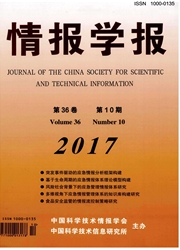

 中文摘要:
中文摘要:
适应性结构化理论(Adaptive Structuration Theory,AST)于1994年提出,已在商业经济、计算机科学、图书情报等领域得到广泛应用。AST结合群决策支持系统(Group Decision Support System,GDSS)环境,从信息技术(Information Technologies,IT)的结构化属性和适应性使用角度阐述信息技术、社会结构和人际交互之间的相互影响。本文以提出AST理论的论文为种子论文,以SSCI/SCI数据库中图书情报领域引用了该论文的文献为考察对象,结合关键词词频统计分析和文献研究,发现国外图书情报领域AST理论应用研究进展主要体现在以下几个方面:AST的相关命题、概念和关系同样适用于非群决策支持系统的信息技术环境,基于组织、群体和个体的多层次研究正在不断地拓展AST理论的外延;AST理论被用来分析IT项目实施的关键成功因素,通常以定性研究为主,从技术的结构化属性角度解释影响IT项目实施的关键成功因素;AST理论被用来分析信息技术采纳后的适应性使用行为,通常以实证研究为主,从微观的功能层面揭示探索性行为、革新性使用以及扩展使用等适应性IT使用行为的前置动因。
 英文摘要:
英文摘要:
The Adaptive Structuration Theory (AST) was proposed in 1994 and has been extensively usea in me t~ctu~ like Business Economics, Computer Science and Information Science Library Science. AST describes the interplay between information technologies, social structures, and human interaction in terms of the structuration of informa- tion technologies (IT) and the adaptive IT use in the context of Group Decision Support System (GDSS). The current paper treats the paper which proposed the AST as the seed paper and examines the papers in the field of Information Science Library Science of SSCI/SCI which cited this seed paper. The word frequency statistics analysis and docu- ment research illustrate the following progress of foreign adaptive structuration theory application research in the field of Information Science Library Science. First, the propositions, concepts and relationship of AST can be applied in other non-GDSS IT contexts. Many research based on organizations, groups and individuals has extended the scope of AST. Second, AST was generally used to analyze key success factors of IT project implementation in the qualita- tive research which explained the key success factors impacting IT project implementation from the perspective of the structuration of IT. Third, AST was generally used to analyze adaptive usage behaviors at the stage of post-adoption in the empirical research which uncovered the determinants of adaptive IT usage behaviors such as exploratory be- haviors, innovative usage and extended usage.
 同期刊论文项目
同期刊论文项目
 同项目期刊论文
同项目期刊论文
 期刊信息
期刊信息
